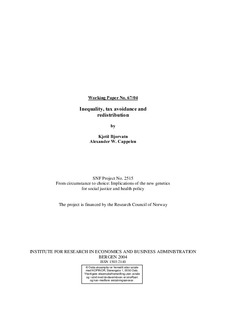Inequality, tax avoidance and redistribution
| dc.contributor.author | Bjorvatn, Kjetil | |
| dc.contributor.author | Cappelen, Alexander W. | |
| dc.date.accessioned | 2006-06-23T11:51:22Z | |
| dc.date.available | 2006-06-23T11:51:22Z | |
| dc.date.issued | 2004-12 | |
| dc.identifier.issn | 1503-2140 | |
| dc.identifier.uri | http://hdl.handle.net/11250/166492 | |
| dc.description.abstract | The present paper seeks to explain the pattern of income redistribution in a world of increased market income inequality. In some countries, larger market income inequality has been met by an increased redistributive effort, thus keeping the distribution of disposable incomes relatively stable. In other countries, larger market inequality has been accompanied by a reduction in transfers, thus leading to growth in disposable income inequality. Focusing on two constraints on tax and redistribution programs, namely dead weight loss and tax avoidance, our analysis demonstrates that the initial level of market income inequality is crucial in explaining how increased inequality affects redistribution. | en |
| dc.format.extent | 227948 bytes | |
| dc.format.mimetype | application/pdf | |
| dc.language.iso | eng | en |
| dc.publisher | SNF | en |
| dc.relation.ispartofseries | Working paper | en |
| dc.relation.ispartofseries | 2004:67 | en |
| dc.subject | inequality | en |
| dc.subject | tax evasion | en |
| dc.subject | redistribution | en |
| dc.title | Inequality, tax avoidance and redistribution | en |
| dc.type | Working paper | en |
Files in this item
This item appears in the following Collection(s)
-
Working papers (SNF) [809]
